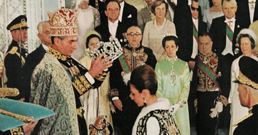The National Jewelry Treasury is one of the most valuable collections of jewels in the world, gathered over many centuries.
Every individual piece is a testimony to the taste and talent of artists and craftsmen of different periods in history. They tell us of the various upheavals of Iranian history, and are reminders of both victories and defeats.
The treasury’s history before the Safavid period (1501-1722) is unknown, and is only recorded after that time. The Safavid kings collected jewelry and had sent experts to purchase jewelry from markets in
With an Afghan invasion of
During the later Qajar period, the jewels were largely protected, with some of them being fixed onto the Kiani Crown, the Naderi Throne, the Bejeweled Globe, and the Peacock Throne.
In 1937, the main portion of this collection was transferred to the National Bank of Iran and used as part of the reserves for the currency. In 1960 the collection, then known as the Crown Jewels, was permanently moved onto the premises of the Central Bank of Iran.
A while ago, the Central Bank of Iran suggested to the Iranian filmmaker, Khosrow Sinai, the making of a documentary on the National Jewelry collection. He began making one, called History’s Witnesses, and it was completed by September 2008.
Regarding this documentary Sinai says: "These jewels are rare stones, and the rarer they are, the more precious they are; however, they are solid and lifeless. When I was asked to make a film about them, the first question that I asked myself was how I could revive those lifeless stones through the documentary."
"The only answer was to relate the jewels to the people with whom they lived, those who sometimes fixed these jewels on the crowns they wore on their heads, or on the swords that they wore at their waists. Therefore, these jewels became witnesses to parts of a nation’s history.”
In the multimedia report we will hear Khosrow Sinai’s comments on the National Jewels and the making of his documentary with some pictures of the collection.


